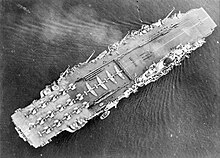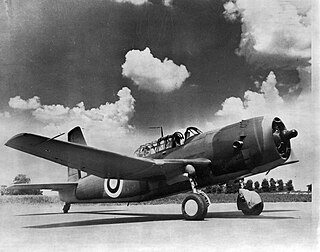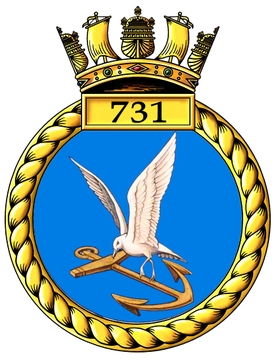Carrier air groups

The Fleet Air Arm squadrons, embarked on the Fleet and Light Fleet aircraft carriers, were placed into Air Groups to align with US Navy policy, once World War II in Europe had ended, to support operations in the Pacific War against the Japanese, in 1945. They were designed with 100% spare groups for Fleet carriers, and 50% spare groups for Light Fleet carriers. [1]
The carrier air groups were divided up based on the aircraft carrier class and using a standardised strength approach of Fleet Air Arm squadrons and aircraft type. Nine of the twenty two groups planned formed up on the 30 June 1945 based on available squadrons, however, one formed as a spare in August 1945, and a number did form post-World War II, or were reactivated at a later date. [2]
| Carrier air group | Aircraft carrier type | Group strength | Date of formation |
|---|---|---|---|
| 1st Carrier Air Group | Illustrious-class fleet carrier | 2 x Corsair squadrons of 15 aircraft each 1 x Avenger squadron of 15 aircraft | June 1945 |
| 2nd Carrier Air Group | 2 x Corsair squadrons of 15 aircraft each 1 x Avenger squadron of 15 aircraft | June 1945 | |
| 3rd Carrier Air Group | 2 x Corsair squadrons of 15 aircraft each 1 x Avenger squadron of 15 aircraft | August 1945 | |
| 4th Carrier Air Group | 2 x Corsair squadrons of 15 aircraft each 1 x Avenger squadron of 15 aircraft | not formed | |
| 5th Carrier Air Group | 2 x Corsair squadrons of 15 aircraft each 1 x Avenger squadron of 15 aircraft | not formed | |
| 6th Carrier Air Group | 2 x Corsair squadrons of 15 aircraft each 1 x Avenger squadron of 15 aircraft | not formed | |
| 7th Carrier Air Group | Implacable-class fleet carrier | 2 x Seafire squadrons of 24 aircraft each 1 x Avenger squadron of 15 aircraft 1 x Firefly of 15 aircraft | June 1945 |
| 8th Carrier Air Group | 2 x Seafire squadrons of 24 aircraft each 1 x Avenger squadron of 15 aircraft 1 x Firefly squadron of 15 aircraft | June 1945 | |
| 9th Carrier Air Group | 2 x Seafire squadrons of 24 aircraft each 1 x Avenger squadron of 15 aircraft 1 x Firefly squadron of 15 aircraft | not formed | |
| 10th Carrier Air Group | 2 x Seafire squadrons of 24 aircraft each 1 x Avenger squadron of 15 aircraft 1 x Firefly squadron of 15 aircraft | not formed | |
| 11th Carrier Air Group | HMS Indomitable | 2 x Hellcat squadrons of 24 aircraft each 1 x Avenger squadron of 15 aircraft 1 x Firefly squadron of 12 aircraft | June 1945 |
| 12th Carrier Air Group | HMS Indomitable | 2 x Hellcat squadrons of 24 aircraft each 1 x Avenger squadron of 15 aircraft 1 x Firefly squadron of 12 aircraft | not formed |
| 13th Carrier Air Group | Colossus-class light fleet carrier | 1 x Corsair squadron of 21 aircraft 1 x Barracuda squadron of 12 aircraft | June 1945 |
| 14th Carrier Air Group | 1 x Corsair squadron of 21 aircraft 1 x Barracuda squadron of 12 aircraft | June 1945 | |
| 15th Carrier Air Group | 1 x Corsair squadron of 21 aircraft 1 x Barracuda squadron of 12 aircraft | June 1945 | |
| 16th Carrier Air Group | 1 x Corsair squadron of 21 aircraft 1 x Barracuda squadron of 12 aircraft | June 1945 | |
| 17th Carrier Air Group | 1 x Corsair squadron of 21 aircraft 1 x Barracuda squadron of 12 aircraft | not formed | |
| 18th Carrier Air Group | 1 x Corsair squadron of 21 aircraft 1 x Barracuda squadron of 12 aircraft | not formed | |
| 19th Carrier Air Group | 1 x Seafire squadron of 21 aircraft 1 x Barracuda squadron of 12 aircraft | not formed | |
| 20th Carrier Air Group | 1 x Seafire squadron of 21 aircraft 1 x Barracuda squadron of 12 aircraft | not formed | |
| 21st Carrier Air Group | 1 x Seafire squadron of 21 aircraft 1 x Barracuda squadron of 12 aircraft | not formed | |
| 22nd Carrier Air Group | 1 x Seafire squadron of 21 aircraft 1 x Barracuda squadron of 12 aircraft | not formed | |
World War II - 1945
- 1st Carrier Air Group - formed on 30 June 1945. It was based on the aircraft carrier HMS Victorious for service in the British Pacific Fleet and comprised 849 Naval Air Squadron flying the Grumman Avenger torpedo bombers, 1834 Naval Air Squadron and 1836 Naval Air Squadron flying the Vought Corsair fighter. It was disbanded on 8 September 1945 when Victorious returned to the United Kingdom. [2]
- 2nd Carrier Air Group - formed on 30 June 1945. It was based on the aircraft carrier HMS Formidable for service in the British Pacific Fleet and contained 848 Naval Air Squadron flying the Avenger, 1841 Naval Air Squadron and 1842 Naval Air Squadron flying the Corsair. It was disbanded on 31 October 1945 when Formidable returned to the United Kingdom. [3]
- 3rd Carrier Air Group - formed on 2 August 1945. It was a spare air group for the British Pacific Fleet based at Nowra. It was formed too late for service in the war, and it contained 854 Naval Air Squadron flying the Avenger with 1843 Naval Air Squadron and 1845 Naval Air Squadron flying the Corsair. It was disbanded on 20 October 1945, and its personnel returned to the United Kingdom onboard a merchant ship. [3]
- 7th Carrier Air Group - formed on 30 June 1945. It was based on the aircraft carrier HMS Indefatigable for service in the British Pacific Fleet and contained 820 Naval Air Squadron flying the Avenger, 887 Naval Air Squadron and 894 Naval Air Squadron flying the Supermarine Seafire fighter and 1770 Naval Air Squadron flying the Fairey Firefly torpedo bomber. It was disbanded in March 1946. [3]
- 8th Carrier Air Group - formed on 30 June 1945. It was based on the aircraft carrier HMS Implacable for service in the British Pacific Fleet and contained 828 Naval Air Squadron flying Avengerss 801 Naval Air Squadron and 880 Naval Air Squadron flying the Seafire and 1771 Naval Air Squadron flying the Firefly. It was disbanded in April 1946, but some of its squadrons disbanded earlier. [3]
- 11th Carrier Air Group - formed on 30 June 1945. It was based on the aircraft carrier HMS Indomitable for service in the British Pacific Fleet and contained 857 Naval Air Squadron flying the Avenger, 1839 Naval Air Squadron and 1844 Naval Air Squadron flying the Grumman Hellcat. It was disbanded on 30 November 1945. [3]
- 13th Carrier Air Group - formed on 30 June 1945. It was based on the aircraft carrier HMS Vengeance for service in the British Pacific Fleet and contained 812 Naval Air Squadron flying the Fairey Barracuda and 1850 Naval Air Squadron flying the Corsair. It was disbanded in August 1946. [3]
- 14th Carrier Air Group - formed on 30 June 1945. It was based on the aircraft carrier HMS Colossus for service in the British Pacific Fleet and contained 827 Naval Air Squadron flying the Fairey Barracuda and 1846 Naval Air Squadron flying the Corsair. It was disbanded on 23 July 1946. [4]
- 15th Carrier Air Group - formed on 30 June 1945. It was based on the aircraft carrier HMS Venerable for service in the British Pacific Fleet and contained 814 Naval Air Squadron flying the Fairey Barracuda and 1851 Naval Air Squadron flying the Corsair. It was disbanded in 1947. [3]
- 16th Carrier Air Group - formed on 30 June 1945. It was based on the aircraft carrier HMS Glory for service in the British Pacific Fleet and contained 837 Naval Air Squadron flying the Fairey Barracuda and 1831 Naval Air Squadron flying the Corsair. It was disbanded in 1947. [3]
During World War II the creation of a 4th, 5th, 6th, 9th, 10th, 12th and 22nd Carrier Air Group also was planned. The surrender of Japan rendered these new carrier air groups unnecessary, and they were never formed. [2] However, the 17th, 18th, 19th, 20th and 21st were formed post-war, with 18 and 19 allocated to the Royal Canadian Navy, and 21 a Royal Australian Navy Air Group [5]
Post World War II
- 17th Carrier Air Group - was intended to be formed for a Colossus-class aircraft carrier, with 824 Naval Air Squadron operating Barracuda aircraft and 1835 Naval Air Squadron equipped with Corsair aircraft. The formation never happened following V-J Day. Instead it was active three times, 1947 to 1949, 1949 to 1950 and in 1952. Initially at the shore base RNAS Eglinton (HMS Gannet) for HMS Theseus, then solely Theseus, formed of Hawker Sea Fury aircraft with 807 Naval Air Squadron and Firefly aircraft with 810 Naval Air Squadron. Third time at RNAS Hal Far for HMS Ocean, formed of Sea Fury aircraft with 802 Naval Air Squadron and Firefly aircraft with 825 Naval Air Squadron. [6]
- 20th Carrier Air Group - was intended to be formed for a Colossus-class aircraft carrier, with 816 Naval Air Squadron operating Barracuda aircraft and 805 Naval Air Squadron equipped with Seafire aircraft. However, it eventually formed at RNAS Lee-on-Solent (HMS Daedalus), in March 1946, for HMS Ocean. At this point 816 NAS had swapped its Barracudas for Fireflys. After operating in the Mediterranean, the group disbanded upon returning to Lee-on Solent, in July 1948. It reformed the same year as a Royal Australian Navy Air Group for HMAS Sydney. [6]
Royal Canadian Navy
- 18th Carrier Air Group - was intended to be formed for a Colossus-class aircraft carrier, with 822 Naval Air Squadron operating Barracuda aircraft and 1855 Naval Air Squadron equipped with Corsair aircraft. This never happened due to the end of the war with Japan. It was reallocated to the RCN, and formed at Dartmouth on the 15 May 1947. [6]
- 19th Carrier Air Group - was initially allocated to the Royal Canadian Navy and was formed at Dartmouth in May 1947. It was made up of 803 Naval Air Squadron, operating Seafires, and 825 Naval Air Squadron which was equipped with Fireflys. [6]
Royal Australian Navy
- 20th Carrier Air Group - Initially a Royal Navy group, it reformed on the 28 August 1948 at RNAS Eglinton, with 805 Naval Air Squadron (Seafires) and 816 Naval Air Squadron (Fireflys), as a RAN air group, for HMAS Sydney. In June 1951, the group disbanded at Nowra. [6]
- 21st Carrier Air Group - was intended to be formed for a Colossus-class aircraft carrier, with 817 Naval Air Squadron operating Barracuda aircraft and 806 Naval Air Squadron equipped with Seafires, in 1946. It eventually formed at RNAS St Merryn as a RAN Air Group in March 1950, made up of 808 Naval Air Squadron equipped with Sea Fury aircraft and 817 Naval Air Squadron, operating with Firefly aircraft, for HMAS Sydney. [7]
Not formed
- 4th Carrier Air Group - was planned to be formed for the aircraft carrier HMS Illustrious for service in the British Pacific Fleet. It was to comprise 846 Naval Air Squadron operating the Avenger, 1837 Naval Air Squadron and 1853 Naval Air Squadron equipped with the Corsair. The plan to form was cancelled following the Japanese surrender [1]
- 5th Carrier Air Group - was planned to be formed as a spare group for an Illustrious-class aircraft carrier. It was to be made up of 852 Naval Air Squadron operating the Avenger, 1832 Naval Air Squadron and 1838 Naval Air Squadron equipped with the Corsair. The plan to form was cancelled following V-J Day. [1]
- 6th Carrier Air Group - was planned to be formed as a spare group for an Illustrious-class aircraft carrier. It was to consist of 853 Naval Air Squadron operating the Avenger, 882 Naval Air Squadron and 1830 Naval Air Squadron equipped with the Corsair. Planned to depart the United Kingdom in January 1946, when 882 NAS re-equipped from Wildcat aircraft. The plan to form was cancelled following V-J Day. [1]
- 9th Carrier Air Group - was planned to be formed as a spare group for an Implacable-class aircraft carrier. It was to consist of 802 Naval Air Squadron and 899 Naval Air Squadron equipped with the Supermarine Seafire, 851 Naval Air Squadron with Avenger and a planned 1773 Naval Air Squadron with the Firefly. The formation was cancelled following V-J Day. [8]
- 10th Carrier Air Group - was planned to be formed as a spare group for an Implacable-class aircraft carrier. It was to be made up of 883 Naval Air Squadron and 1833 Naval Air Squadron equipped with the Supermarine Seafire, 856 Naval Air Squadron with Avenger and a planned 1775 Naval Air Squadron with Fireflys. The plan was cancelled following V-J Day. [8]
- 12th Carrier Air Group - was planned to be formed as a spare group for the aircraft carrier HMS Indomitable. It was to contain 845 Naval Air Squadron with Avenger aircraft, 881 Naval Air Squadron and 885 Naval Air Squadron with Hellcat aircraft and a planned 1774 Naval Air Squadron with Firefly aircraft. This was cancelled following V-J Day. [8]
- 22nd Carrier Air Group - was planned to be formed in service for a Colossus-class aircraft carrier. It was to be formed of 818 Naval Air Squadron operating Barracuda aircraft and 884 Naval Air Squadron equipped with Seafire aircraft. The formation never happened following V-J Day. [7]













